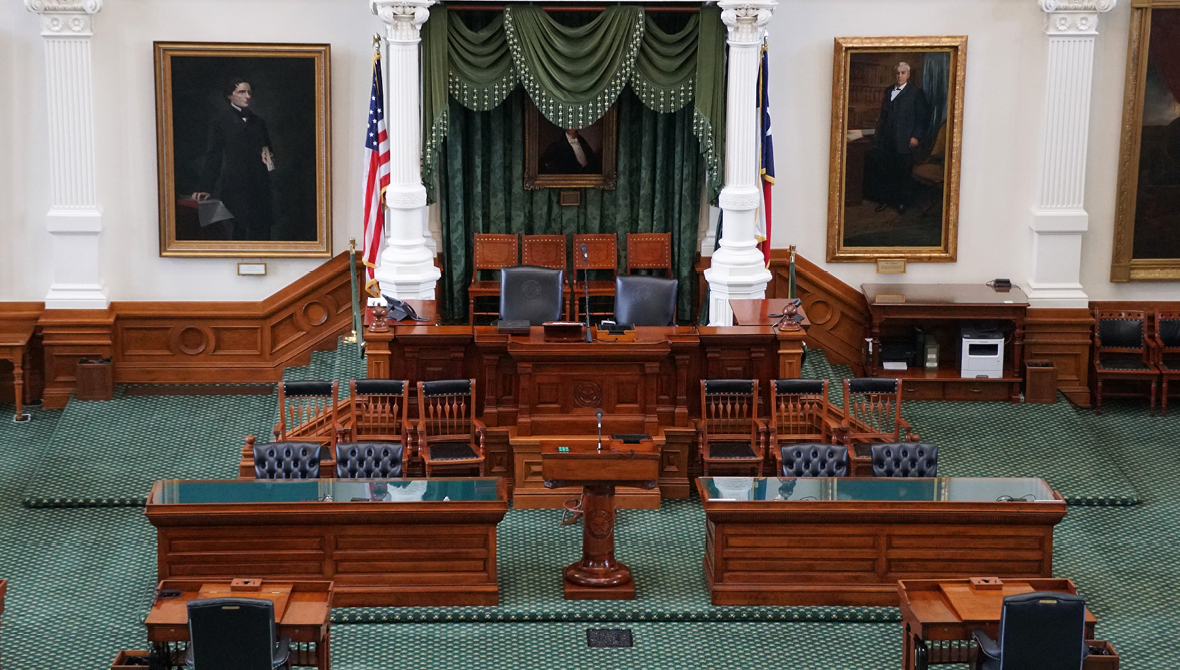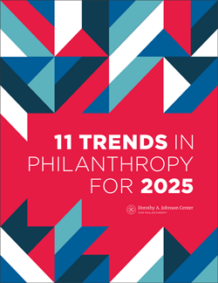Four Key Factors are Driving a Surge in Nonprofit Lobbying Activities


 This article was first published in our 11 Trends in Philanthropy for 2025 report. Explore the full report here.
This article was first published in our 11 Trends in Philanthropy for 2025 report. Explore the full report here.
Want the latest trends, research, and more delivered right to your inbox? Subscribe to the Johnson Center email newsletter.
At the dawn of a new presidential administration, when legislators and executives around the country are welcoming colleagues and forming and reforming coalitions, many nonprofits and network organizations are doing the same, looking to build relationships and forge partnerships with decision-makers. While there is a distinction to be made between lobbying activities that are intended to benefit the sector at large — such as lobbying for the creation of a universal charitable tax credit — versus issue-area advocacy — such as lobbying for increased public education funding — there are four significant reasons why lobbying activities of any kind are likely to increase in 2025 and beyond:
As the nonprofit sector has gotten larger over the past 30 years, more nonprofits in the field naturally equates to a rise in the absolute number of lobbying activities going on. In Independent Sector’s report, The Retreat of Influence: Exploring the decline of nonprofit advocacy and public engagement, researchers Falk et al. (2023) looked specifically at the number of public charities reporting lobbying activities over two decades. They compared a subset of organizations present in nonprofits’ IRS Form 990 tax records1 (excluding hospitals and higher education organizations) in 2003 to a sample with the same parameters in 2023. They identified 8,571 “lobbying public charities” (meaning nonprofits reporting lobbying activities to the IRS) in 2003 and 10,233 in 2023 (p. 18).
Additional analysis revealed that many organizations had added lobbying activities to their portfolios. Of those organizations that existed and filed a Form 990 in both 2003 and 2023, Falk et al. (2023) found that 38% “began reporting lobbying activities between 2003 and 2023 when they had not before” (p. 18). Combined with the number of new public charities entering the sector that filed lobbying expenses, overall, the authors found that “7,366 (or 72% of current public charities that report lobbying) began lobbying activities within the last 20 years” (p. 18).
In their book, Standing Up for Nonprofits, Alan J. Abramson and Benjamin Soskis (2024) traced the development of sector-wide advocacy and lobbying efforts at the federal level, focusing heavily on what they call the “Big Five” advocacy organizations (p. 3): the Council on Foundations, the National Council on Nonprofits, Independent Sector, the United Philanthropy Forum, and the Philanthropy Roundtable.
While Abramson and Soskis focused heavily on analyzing the state of sector advocacy throughout and following the passage of the Tax Cuts and Jobs Act (TCJA) in 2017 and the federal response to COVID-19, their story also demonstrates the significant evolution and growth of this arm of the sector. The oldest of these national philanthropic infrastructure organizations — the Council on Foundations — dates its origin to 1949, while the youngest — the United Philanthropy Forum — was established in 1998. After decades of evolution and sharpening their skills and constituencies, the Big Five have become a significant force. In 2022, these organizations spent a combined $40.7 million on advocacy and lobbying activities and organizational expenditures (2024, pp. 4-9).
When Congress set about rewriting portions of the federal tax code in 2017, proposing to double the standard deduction for individuals and married couples, nonprofit professionals and sector advocates alike passionately voiced concern that charitable giving would take a hit. According to 2024 research from the National Bureau of Economic Research, their concerns were more than legitimate. In the first year following the passage of TCJA, a research team determined that 23 million fewer households itemized their taxes, leading to a drop of approximately $20 billion in giving (Han et al., 2024).
For almost seven years, researchers in the nonprofit sector could only examine slices of data and do their best to untangle the direct impact of TCJA’s policy changes on charitable giving. With this new data from Han et al. (2024), we know for sure what’s at stake in the next round of tax code rewrites scheduled for 2025. The critical opportunity and need for effective lobbying practices that can help the sector make up lost ground and perhaps even help to slow, stabilize, or reverse the troubling trend of declining household participation in charitable giving (Moody, 2022), is very real — and very imminent.
In the original version of the Paycheck Protection Program (PPP) debated in the U.S. Senate in 2020, any nonprofit receiving funds from Medicaid would have been ineligible to participate in the program (Abramson & Soskis, 2024, p. 49). It was the lobbying efforts of the Big Five, as part of a larger coalition of organizations working on behalf of the sector, that ensured the provision was removed before the final bill was signed. According to Johnson Center research (Williams, 2020), PPP loans ultimately protected 4.1 million nonprofit jobs in 2020.
Alongside lifting the cap on annual giving deductions and instituting a short-term charitable giving tax credit, the CARES Act ultimately proved a significant — if not unqualified — success for the sector. Abramson and Soskis wrote:
Advocates noted several significantly improved dynamics in their work compared to the lobbying campaign during the TCJA deliberations. First, many of those interviewed noted how much better sector advocates worked together. In part, this was because many members of the group had developed working relationships during the TCJA deliberations as well as a productive division of labor. (p. 50)
Efforts at the state level have also showed how successful and important nonprofit lobbying activities can be. As examples, the Michigan Nonprofit Association (n.d.) secured $35 million from the State and Local Fiscal Recovery Funds (SLFRF), while the Kentucky Nonprofit Network (2023) was able to secure $75 million.
What’s standing in the way? Despite efforts from the Big Five and others — see Exponent Philanthropy’s recent “Foundation Advocacy Intensive” and “An Introduction to Advocacy as a Change Strategy for Nonprofits” from Community Commons, as examples — to educate the sector about what organizations can and cannot do, a murkiness remains. Part of this confusion comes from the daunting “legalese” of IRS regulations and forms. Another factor is public opinion: whether our donors, communities, board members, and advisors seem to think we should be part of a conversation or not, or provide faulty guidance one way or another.
In the end, if the nonprofit sector is committed to systems change in order to improve outcomes for the most people, they will have to engage with the systems — and the systems makers — themselves. That means working with policymakers, legislators, executives, and others at all levels of government. As more organizations and networks come to understand this reality — and pair that with a better understanding of what they are legally empowered to do — we’re likely to see a continued increase in lobbying activities and greater visibility and voice for the sector in key public policy decisions.
The IRS draws a distinction between 501(c)(3) charitable nonprofits and private foundations in their regulation of lobbying activities. Charitable nonprofits are allowed to engage in a certain number of lobbying activities provided they file the proper paperwork.
Private foundations, however, are largely prohibited from engaging in direct lobbying, except in their own defense. They are, however, allowed to make grants that could be used for lobbying activities by charitable nonprofits.
For these reasons, the term “nonprofit” is used throughout this article to refer specifically to 501(c)(3) charitable nonprofits, not to private foundations.
For more information, see resources like “Bolder Advocacy” from Alliance for Justice and Candid’s “Can nonprofits engage in advocacy or lobbying efforts?”
1Prentice (2018) offers an important caveat to these findings. In The ‘State’ of Nonprofit Lobbying Research: Data, Definitions, and Directions for Future Study, Prentice explores in depth the challenges of accurately understanding the state of nonprofit lobbying efforts using Form 990 data. “Understanding how and where to report lobbying activities and expenditures is complex and requires legal and accounting expertise. Form 990 contributes to this complexity by requiring tax-exempt organizations to account for their lobbying activities and expenses in various ways and in multiple locations on the return” (p. 208S). (See Prentice’s Figure 1, p. 209S, for as clear an explanation as I have found). It is therefore entirely possible that the number and proportion of nonprofits that engaged in lobbying activities could be much higher than Falk et al. (2023) found (assuming nonprofits that reported engaging in lobbying activities on their IRS Form 990 reviewed for the research did so accurately).
Abramson, A., & Soskis, B. (2024, May 23). Standing up for nonprofits: Advocacy on federal, sector-wide issues. Elements in Public and Nonprofit Administration. Cambridge University Press. https://doi.org/10.1017/9781009401081
Faulk, L., Kim, M., & MacIndoe, H. (2023). The retreat of influence: Exploring the decline of nonprofit advocacy and public engagement. Independent Sector. http://www.independentsector.org/policy/advocacyresearch
Han, X., Hungerman, D. M., & Ottoni-Wilhelm, M. (2024). Tax incentives for charitable giving: New findings from the TCJA (Working Paper No. 32737). National Bureau of Economic Research. https://doi.org/10.3386/w32737
Kentucky Nonprofit Network. (2023, March 9). Kentucky nonprofits celebrate $75 million investment at state [Press release]. https://www.kynonprofits.org/sites/default/files/2023%20DAC%20press%20release%20post.pdf
Michigan Nonprofit Association. (n.d.) Nonprofit relief fund. Accessed October 1, 2024. https://www.mnaonline.org/policy/nonprofit-relief-fund
Moody, M. (2022, January 18). Increasing attention to the decline in household giving to nonprofits. 11 Trends in Philanthropy for 2022. Dorothy A. Johnson Center for Philanthropy at Grand Valley State University. https://johnsoncenter.org/blog/increasing-attention-to-the-decline-in-household-giving-to-nonprofits/
Prentice, C. (2018). The “state” of nonprofit lobbying research: Data, definitions, and directions for future study. Nonprofit and Voluntary Sector Quarterly, 47(4S), 204S–217S. https://doi.org/10.1177/0899764018758957
Williams, J. (2020, July 21). In the time of coronavirus: How many eligible nonprofits benefited from the Paycheck Protection Program? Dorothy A. Johnson Center for Philanthropy at Grand Valley State University. https://johnsoncenter.org/blog/in-the-time-of-coronavirus-how-many-eligible-nonprofits-benefited-from-the-paycheck-protection-program/